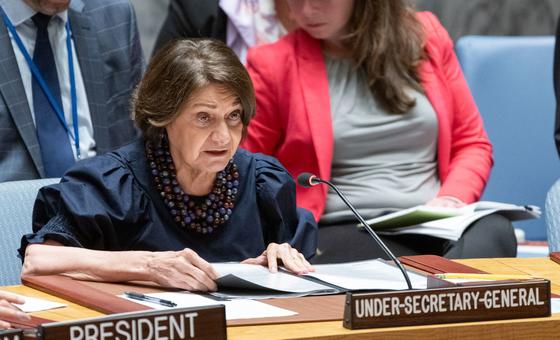Briefing the Security Council on the state of the JCPOA, Ms. DiCarlo set the tone for the discussion by stating, “diplomacy is the only way to effectively address the Iranian nuclear issue.”
The 2015 deal sets out rules for monitoring Iran’s nuclear programme and paves the way for the lifting of UN sanctions. It was agreed by Iran, the five permanent members of the Security Council (China, France, Russia, the United Kingdom, the United States), plus Germany, together with the European Union.
The US left the deal in 2018 under former President Donald Trump and has been negotiating its return, so far without any agreement being reached.
The Under-Secretary-General for Political and Peacebuilding Affairs regretted that negotiations to restore the Plan remain stalled even though all participants, including the US, have reaffirmed that “a return to the full and effective implementation of the Plan” was the only viable option.
Devised and endorsed by the Security Council resolution 2231, the Plan offers a solution where Iran’s nuclear facilities are used only for peaceful purposes. In return sanctions are to be lifted, bringing “tangible economic benefits for the Iranian people”, reminded Ms. DiCarlo.
She reiterated the Secretary-General’s appeal to the US to lift or waive its sanctions and to extend waivers regarding the trade in oil with Iran. She also repeated the UN chief’s call on Iran to “reverse the steps it has taken that are not consistent with its nuclear-related commitments under the Plan.”

IAEA safeguards
She said following a “welcome” joint statement by the International Atomic Energy Agency (IAEA) and Iran in March, surveillance cameras were installed at workshops where centrifuge parts are manufactured.
The UN-backed nuclear watchdog also reported in May that it had no further concerns regarding the presence of highly enriched uranium which had been detected at one location.
However, the UN is alarmed that the agency remains unable to verify the stockpile of enriched uranium in the country. Citing the IAEA estimates, Rosemary DiCarlo said “Iran now has a total enriched uranium stockpile of more than twenty times the allowable amount under the (JCPOA). This includes increased quantities of uranium enriched to 20 per cent and 60 percent.”
Divergent views
Addressing the deal’s ballistic missile-related provisions, she referred to the information received from France, Germany, Iran, Israel, Russia, and the UK about Iran’s test flight of a space launch vehicle in March, as well as to the testing and unveiling of two new ballistic missiles by Iran, in May and June.
“The letters received from Member States continue to reflect the divergent views as to whether this launch and missile developments are inconsistent with the resolution,” Ms. DiCarlo told ambassadors.
She also detailed information received on ballistic missile parts seized by the British Royal Navy in February, in international waters in the Gulf of Iran.
While France, Germany and the UK believe that some were controlled items originating from Iran and transferred contrary to resolution 2231, Iran and the Russia responded that there was no evidence linking the intercepted vessel and its cargo to Iran, and no clear indication that the seized components were of Iranian origin.
Alleged transfers to Russia, Yemen
Ms. DiCarlo next detailed letters received from Member States concerning alleged transfers of drones or unmanned aerial vehicles (UAVs) from Iran to Russia for use on the battlefield in Ukraine, in a manner inconsistent with paragraph 4 of annex B”.
She said their assessment had been determined by comparing debris from other UAV attacks in the Middle East and publicly available imagery of Iranian UAVs.
They have invited the UN Secretariat to examine debris now stored in Kyiv and elsewhere, to make a determination.
Iran and Russia have disputed the imagery of the UAVs “noting that the accusations were not substantiated by evidence”, said the political affairs chief.
Assuring that the UN “continues to examine the available information”, she added that the Government of Yemen has also invited the UN to examine debris from a cruise missile used in an attack by Houthi rebels on the Al-Dhaaba oil terminal last November.
‘Best available option’
Despite the strongly opposing views aired in the Council from States involved in the JCPOA, Ms. DiCarlo said it remained “the best available option for ensuring the exclusively peaceful nature of Iran’s nuclear programme, as well as for allowing Iran to reach its full economic potential.”

